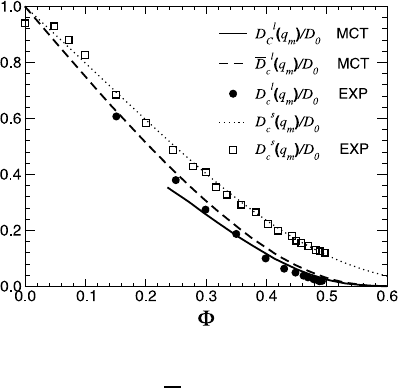Heitjans P., Karger J. (Eds.). Diffusion in Condensed Matter: Methods, Materials, Models
Подождите немного. Документ загружается.


650 Gerhard N¨agele, Jan K. G. Dhont, and Gerhard Meier
to the large osmotic compressibility of near-critical systems. The dynamics
of such systems is thus very slow (critical slowing down).
On various places we have noted that, aside from small wavenumbers
q q
m
, S
c
(q, t) decays in general non-exponentially in time. However, recent
calculations of S
c
(q, t) for concentrated suspensions with pronounced particle
caging have revealed that the dynamic structure factor of these systems does
decay exponentially for long times, for wavenumbers centered around q
m
.The
existence of such a collective long-time mode
S
c
(q
m
,t) ∝ exp{−q
2
D
l
c
(q
m
)t},t τ
I
(16.110)
characterized by a collective long-time diffusion coefficient, D
l
c
(q
m
), at the
finite wave number q
m
has been observed indeed in DLS experiments on
concentrated suspensions of hard spheres. This peculiar mode describes the
decay of concentration fluctuations linked to the average extension of a near-
est neighbor cage. According to theory, the long-time mode ceases to exist
when the volume fraction of hard spheres is reduced below 0.2. The caging
effect is then too small and S
c
(q
m
,t) decays non-exponentially at long times.
The long-time coefficient D
l
c
(q
m
) should be distinguished from the q-
dependent mean collective diffusion coefficient,
D
c
(q). The latter is defined
as
D
c
(q) ≡ D
c
(q, z =0) = D
s
c
(q) −
∞
0
dt∆D
c
(q, t) , (16.111)
and is related to the mean relaxation time,
τ(q), of S
c
(q, t) through
τ(q) ≡
∞
0
dt
S
c
(q, t)
S
c
(q)
=
1
q
2
D
c
(q)
. (16.112)
Contrary to D
l
c
(q), the coefficient D
c
(q) is not a true long-time diffusion
coefficient although this has been erroneously claimed. If D
c
(q, t) would decay
sufficiently faster than S
c
(q, t), the memory integral in (16.89) could then be
de-convoluted for t τ
I
as
t
0
dt
D
c
(q, t − t
) S
c
(q, t
) ≈ D
c
(q, z =0)S
c
(q, t) . (16.113)
If this holds true then
D
c
(q) would be a genuine long-time diffusion coefficient
with S
c
(q, t τ
I
) ∝ exp{−q
2
D
c
(q)t}. However, D
c
(q, t) decays so slowly for
finite q that the de-convolution is strictly valid only in the hydrodynamic
limit, where
D
c
(q) reduces to D
l
c
. Contrary to D
l
c
(q) the mean collective
diffusion coefficient is defined for any concentration and all values of q,even
those where S
c
(q, t) is non-exponential at long times. Note that the ordering
relations
D
s
c
(q) > D
c
(q) >D
l
c
(q) (16.114)
are valid for the range of q and Φ where D
l
c
(q) exists. A comparison between
the coefficients D
l
c
(q
m
)andD
c
(q
m
) of hard spheres, as predicted by theory, is

16 Diffusion in Colloidal and Polymeric Systems 651
Fig. 16.11. Mode coupling theory (MCT) prediction (from [24]) for the concen-
tration dependence of the collective long-time coefficient D
l
c
(q
m
), and for the mean
collective coefficient
D
c
(q
m
) of hard-sphere suspensions. The experimental data for
D
l
c
(q
m
) are from [25]. For comparison, we include experimental data (from [26]) for
the short-time D
s
c
(q
m
)/D
0
with corresponding theoretical predictions from (16.213,
16.214).
made in Fig. 16.11. This figure includes also DLS data for D
l
c
(q
m
) which agree
well with theory. The difference between both coefficients is rather small over
the complete range of volume fractions where D
l
c
(q
m
) exists.
Interdiffusion
So far we have explored diffusion processes in one-component systems of
identical particles, as far as the sizes and interaction properties are concerned.
In colloidal mixtures, and of course also in atomic and polymer mixtures, an
additional interdiffusion mechanism comes into play related to the relaxation
of thermal fluctuations in the relative concentration of two components. For
simplicity, we will discuss only the most simple case of interdiffusion in binary
colloidal dispersions of spherical particles, and in a ternary incompressible
melt of two homopolymer species mingled in a matrix of a third homopolymer
species. We will address in particular the question whether the interdiffusion
coefficient can be expressed alone in terms of the self-diffusion coefficients of
both components.
The interdiffusion process mediates the relaxation of thermal fluctuations
(under isothermal and isobaric conditions) in the relative particle (monomer)
concentration of two components, say component 1 and 2, towards their
equilibrium values. There might be additional components present but we
focus here on the concentration exchange between components 1 and 2. The
Fourier transform of the incremental microscopic number density of compo-
nent α =1, 2, relative to its mean density ρ
α0
= N
α
/V
s
,reads

652 Gerhard N¨agele, Jan K. G. Dhont, and Gerhard Meier
ρ
α
(q, t)=
N
α
j=1
exp{iq · r
α
j
}−N
α
δ
q,0
, (16.115)
with ρ
α
(q, t) = 0. Here, r
α
j
is the center-of-mass position vector of the j-
th sphere (monomer) of component α,andN
α
is the number of particles of
species α in the scattering volume. Small fluctuations in the relative local
concentrations of 1-particles with respect to component 2 are quantified by
the microscopic concentration variable
ρ
in
(q,t) ≡
1
√
N
[x
2
ρ
1
(q,t) − x
1
ρ
2
(q,t)] , (16.116)
with N = N
1
+ N
2
and partial molar fraction x
α
= N
α
/N . The interdiffusion
process is thus related to the relaxation of ρ
in
(q,t), whose de-correlation in
time is described by the interdiffusion autocorrelation function
S
in
(q, t)=ρ
in
(q,t) ρ
in
(−q, 0)
= x
1
x
2
x
2
S
11
(q, t)+x
1
S
22
(q, t) − 2(x
1
x
2
)
1/2
S
12
(q, t)
. (16.117)
The interdiffusion function S
in
(q, t) has been further denoted in the liter-
ature on X-ray and neutron scattering as the Bhatia-Thornton dynamic
concentration-concentration structure factor. It is a special linear combina-
tion of three partial collective dynamic structure factors [18]
S
αβ
(q, t)=
1
(N
α
N
β
)
1/2
ρ
α
(q,t)ρ
β
(−q, 0), (16.118)
with α, β ∈{1, 2} and S
12
= S
21
. The partial structure factors, S
αβ
(q, t),
describe time-correlations in the density fluctuations of components α and β,
and they form the elements of a symmetric and positive definite 2×2matrix
S(q, t). This matrix is the extension of the collective dynamic structure factor
S
c
(q, t) of a monodisperse system to binary mixtures. Note that the factors
N
−1/2
and (N
α
N
β
)
−1/2
in (16.116) and (16.118), respectively, have been
introduced to make S
in
(q, t)andS(q, t) intensive. The EACF for polarized
single scattering from a binary mixture can be expressed in terms of the
dynamic structure factor matrix as
g
E
(q, t) ∝ f
2
1
S
11
(q, t)+f
2
2
S
22
(q, t)+2f
1
f
2
S
12
(q, t)
= f(q)
T
· S(q, t) · f (q) , (16.119)
where we have introduced the column vector f =[f
1
,f
2
]
T
of partial scat-
tering strengths f
α
= x
1/2
α
b
α
. For a binary colloidal suspension, b
α
is the
excess scattering amplitude of a sphere of component α =1, 2relativetothe
solvent. For a ternary homopolymer blend, b
α
is the scattering amplitude of

16 Diffusion in Colloidal and Polymeric Systems 653
an α-type monomer relative to the scattering strength of a matrix monomer.
In principle, the three partial dynamic structure factors could be measured
individually by index matching each of the two interdiffusing components
separately to the solvent (matrix). Unfortunately, such an index matching is
quite difficult to do from an experimental point of view and has been achieved
to date only for a few selected systems. The index matching method is to
some extent analogous to the isotope substitution technique used in neutron
scattering.
We are interested here in the hydrodynamic regime (i.e. q → 0andt →∞
with q
2
t fixed) where the internal structure of the colloidal spheres and ho-
mopolymers, and the internal dynamics of the individual homopolymers are
not resolved. In this regime, the scattering amplitudes become independent
of q. The time evolution of the matrix S(q, t) is shown in the hydrodynamic
limit to be governed by
S(q, t)=exp{−q
2
D
l
c
t}·S(0) , (16.120)
where D
l
c
is the 2×2 long-time collective diffusion matrix, and S(0) = S(q →
0,t = 0) is the matrix of partial static structure factors in the small-q limit.
Equation (16.120) extends (16.94) to (binary) mixtures. It is found that D
l
c
is in general not symmetric. However, it can be diagonalized and it possesses
real and positive eigenvalues d
+
and d
−
, as one expects for an overdamped
system. To see this, we introduce the symmetric and positive definite matrix,
µ
l
, of long-time partial mobilities µ
αβ
through [27, 28]
D
l
c
= k
B
T µ
l
· S(0)
−1
. (16.121)
A trivial example is provided for a system of non-interacting particles, where
µ
l
αβ
= δ
αβ
D
0α
/(k
B
T ). The symmetry and positive definiteness of µ
l
is a
consequence of the symmetry of S(q, t), and its monotonic decay in the hy-
drodynamic limit. That D
l
c
is diagonalizable with positive eigenvalues arises
then from the possibility to express it as the product of a symmetric and pos-
itive definite matrix µ
l
and a symmetric matrix S
−1
. Explicit diagonalization
of D leads to the normal-mode expansion [28]
S(q, t)=A
+
exp{−q
2
d
+
t} + A
−
exp{−q
2
d
−
t} (16.122)
of S(q, t) as a sum of two exponentially decaying diffusive modes. The am-
plitudes A
+
and A
−
can be expressed in terms of the elements of S(0) and
µ
l
. The eigenvalues of D are given by
d
±
= D
av
±
(
D
2
av
−|D| (16.123)
with D
av
=[D
11
+ D
22
] /2and|D| = D
11
D
22
− D
12
D
21
.Incaseofabi-
nary colloidal dispersion, the bimodal relaxation described by (16.122) arises
from the large differences in the relaxation times of colloidal particles and

654 Gerhard N¨agele, Jan K. G. Dhont, and Gerhard Meier
solvent molecules. In contrast, the relaxation time of the polymer matrix,
which plays the role of the “solvent” in the ternary homopolymer mixture, is
comparable to those of the other two components. The bimodal relaxation is
here a consequence of the incompressibility constraint
ρ
1
(q)+ρ
2
(q)+ρ
3
(q)=0, (16.124)
valid in the diffusive limit, which enables one to express the dynamics of
one component, identified as the “matrix”, in terms of the other ones. For
simplicity, we have assumed here that the segmental volumes of all three
homopolymer species are equal to each other. It is clear that S(q, t)inthe
general case will contain as many exponentially decaying modes as the num-
ber of independent components.
It follows from (16.117) and (16.122) that
S
in
(q, t)=x
1
x
2
e
T
· S(q, t) · e , (16.125)
with e =
!
√
x
2
, −
√
x
1
"
T
, is a superposition of two decaying modes. Neverthe-
less, the initial decay of S
in
(q, t) in the hydrodynamic limit can be described
for t 1/d
+
by the single-exponential form
S
in
(q, t) ≈ exp{−q
2
D
l
in
t}, (16.126)
which defines the long-time interdiffusion coefficient, D
l
in
,as
D
l
in
= lim
t→∞
lim
q→0
−
1
q
2
∂
∂t
ln S
in
(q, t)
. (16.127)
By matching the initial relaxation rates in (16.125) and (16.126), we find,
using (16.121), that
D
l
in
=
Λ
l
in
S
in
(0)
, (16.128)
with
Λ
l
in
= k
B
Tx
1
x
2
e
T
· µ
l
· e (16.129)
= k
B
Tx
1
x
2
x
2
µ
l
11
+ x
1
µ
l
22
− 2(x
1
x
2
)
1/2
µ
l
12
.
We note that D
l
in
is expressed here as a product of a kinetic factor, Λ
l
in
> 0,
and a thermodynamic factor equal to 1/S
in
(q = 0). For a binary mixture of
particles nearly identical in their interactions, S
in
(0) ≈ x
1
x
2
. For systems
with S
in
(0) <x
1
x
2
(S
in
>x
1
x
2
) the particles of components 1 and 2 have
the tendency to mix (de-mix).
The kinetic factor can be expressed by the Green-Kubo formula
Λ
l
in
= lim
q→0
∞
0
dt j
in
(q,t) j
in
(−q, 0), (16.130)

16 Diffusion in Colloidal and Polymeric Systems 655
where
j
in
(q,t)=
√
Nx
1
x
2
⎡
⎣
1
N
1
N
1
j=1
v
(1)
j
exp{iq · r
(1)
j
}−
1
N
2
N
2
j=1
v
(2)
j
exp{iq · r
(2)
j
}
⎤
⎦
(16.131)
is the interdiffusion flux related to ρ
in
(q,t). Here, v
(1)
j
and v
(2)
j
denote the
longitudinal (i.e. parallel to q) velocities of component 1 and 2 particles. The
interdiffusion flux is seen to be closely related to the relative velocity of the
center-of-positions of the two components in the mixture. The derivation of
(16.130) can be represented quite generally [28, 29] for any density function
ρ(q,t) in Fourier space satisfying the continuity equation
˙ρ(q,t)=iqj(q,t) . (16.132)
Here j(q,t) is the longitudinal component of the flux vector j(q,t)associated
with ρ(q,t), and the dot denotes differentiation with respect to time. The
long-wavelength limit of the current autocorrelation function follows then as
lim
q→0
j(q,t) j(−q, 0) = lim
q→0
1
q
2
˙ρ(q,t)˙ρ(−q, 0)
= − lim
q→0
1
q
2
∂
2
S(q, t)
∂t
2
(16.133)
where S(q, t)=ρ(q,t)ρ(−q, 0). For the most right equality we have used the
stationarity property which states that equilibrium time-correlation functions
are invariant to a shift in the time origin. Next we integrate (16.133) with
respect to time to obtain
lim
q→0
t
0
dt
j(q,t
) j(−q, 0) = − lim
q→0
1
q
2
∂
∂t
S
in
(q, t) (16.134)
where the initial condition
∂
∂t
S(q, t)|
t=0
= 0 (16.135)
has been used. This initial condition is a consequence of time reversibility,
i.e. A(t)A(0) = A(−t)A(0) for any dynamic variable A obeying the deter-
ministic Liouville equation. The initial slope of any autocorrelation function
is thus zero in Liouville dynamics. Of course, this does not hold for the ir-
reversible dynamical regime described by diffusion equations (e.g., (16.45)),
wherein the microscopic short-time regime t τ
B
remains unresolved. The

656 Gerhard N¨agele, Jan K. G. Dhont, and Gerhard Meier
transition to the hydrodynamic regime follows from taking the long-time limit
of (16.135). This gives the exact relation
lim
q→0
∞
0
dt j(q,t) j(−q, 0) = − lim
t→∞
lim
q→0
1
q
2
∂
∂t
S(q, t) , (16.136)
where the order of the limits is not interchangeable. In specializing this
equation to interdiffusion, the Green-Kubo formula for Λ
l
in
is readily ob-
tained from substituting the hydrodynamic limit form of S
in
(q, t) as given in
(16.122). When (16.136) is specialized to self-diffusion by choosing ρ(q,t)=
exp{iq · r
1
(t)} and using that S
s
(q, t)=exp{−q
2
D
l
s
t} in the hydrodynamic
limit, one is led to the Green-Kubo formula for the VAF given in (16.73).
For self-diffusion, Λ
l
s
= D
l
s
, since the thermodynamic factor 1/S
s
(q, t =0)is
equal to one even for finite q.
For colloidal mixtures, one needs to distinguish between the short-time
and long-time interdiffusion coefficient. The definition of D
s
in
= Λ
s
in
/S
in
(0)
and of its associated short-time kinetic factor Λ
s
in
follows from considering
the time evolution equation
∂
∂t
S(q, t)=−q
2
D
s
c
(q) · S(q, t)+q
2
t
0
dt
∆D
c
(q, t − t
) · S(q, t
) (16.137)
for S(q, t), which constitutes the generalization of (16.101) to colloidal mix-
tures. Here ∆D
c
(q, t)isa2×2-matrix of collective memory functions, related
to the long-time collective diffusion matrix in (16.121) by (cf. (16.103))
D
l
c
= D
s
c
− lim
q→0
∞
0
dt∆D
c
(q, t) , (16.138)
with the short-time collective diffusion matrix D
s
c
= lim
q→0
D
s
c
(q). Introduc-
ing the short-time mobility matrix through D
s
c
= k
B
T µ
s
· S(0)
−1
, Λ
s
in
can
be defined in analogy to the long-time kinetic coefficient as
Λ
s
in
= k
B
Tx
1
x
2
e
T
· µ
s
· e . (16.139)
Contrary to the one-component case, where D
s
c
= D
l
c
for systems with pair-
wise additive HI, one finds for mixtures that D
s
c
= D
l
c
, and hence Λ
l
in
<Λ
s
in
and D
l
in
<D
s
in
, even so when HI is neglected. The reason for the different
physical behavior of mixtures is that particles of different components diffuse
differently fast under a constant density gradient. Hence, the equilibrium mi-
crostructure becomes distorted at longer times. For the memory matrix this
implies that lim
q→0
∆D(q,t) =0.
The interdiffusion coefficient describes the relaxation of thermally excited
fluctuations in the relative composition through the collective motion of par-
ticles. Therefore, there is no reason to expect that, except from a few limiting
cases, D
l
in
can be expressed solely in terms of the self-diffusion coefficients
16 Diffusion in Colloidal and Polymeric Systems 657
D
l
sα
=
∞
0
dtv
α
i
(t)v
α
i
(0) (16.140)
of both components, with v
α
i
denoting the longitudinal velocity of a com-
ponent α particle. That there are collective contributions to D
s
in
which are
not contained in the self-diffusion coefficients was explicitly shown for fluid
atomic mixtures in [30]. The importance of collective contributions to D
in
will be exemplified in Sect. 16.5.1 for mixtures of colloidal hard spheres.
An ideal binary mixture is characterized by
Λ
l
in
∝ x
2
D
l
s1
+ x
1
D
l
s2
, (16.141)
i.e. the kinetic factor can be expressed solely in terms of a weighted sum
of the self-diffusion coefficients. Ideality is implied, in particular, according
to (16.130), when velocity cross-correlations v
i
(t)v
j
(0) between different
particles i = j vanish or mutually cancel each other for all t. A trivial example
of an ideal system is a binary suspension of non-interacting particles (cf.
(14.2) in Chap. 14), where
D
l
in
= D
s
in
= x
2
D
01
+ x
1
D
02
. (16.142)
Here, D
0α
is the free diffusion coefficient of an α-type particle. Equation
(16.141) is the fast-mode expression for interdiffusion since for D
s1
D
s2
,
D
in
is dominated by the self-diffusion coefficient of the fast component 1. The
fast-mode form of D
in
is approximately valid for mixtures of Lennard-Jones-
type fluids like argon-krypton. However, there are severe deviations from
the fast-mode form for mixtures of strongly dissymmetric particles. Perfect
ideality is reached only for symmetric bimodal systems, where the particles of
both components differ only in their labelling (e.g. in their optical properties).
In this limiting case, S
in
(0) = x
1
x
2
,and
D
in
= D
s
(16.143)
for arbitrary concentration and particle interactions. Not unexpectedly, this
means that the concentration exchange between the two components is only
driven by self-diffusion. The interdiffusion coefficient in a symmetric mixture
is thus identical with the self-diffusion coefficient. Since all particles are iden-
tical regarding their sizes and interactions, there is no gradient in the local
chemical potential difference of both species. Each particle experiences a uni-
form environment as in the case of self-diffusion. An ideal bimodal system in
the hydrodynamic limit is further characterized by
d
−
= D
in
,d
+
= D
c
(16.144)
with d
−
<d
+
. The eigenmode with decay constant d
−
(d
+
)isthusidentified
with the interdiffusion (collective diffusion) process, and D
in
and D
c
can be
extracted, using index matching, from a single measurement of the EACF

658 Gerhard N¨agele, Jan K. G. Dhont, and Gerhard Meier
of the unmatched (labelled) component α, since then g
E
(q, t) ∝ S
αα
(q, t).
The two normal modes cannot be identified, in general, as interdiffusion and
collective diffusion processes. Moreover, D
in
cannot be extracted, in general,
from the measurement of a single dynamic structure factor, say S
11
(t), of one
component. One needs a second experiment, in which the first component is
matched away and S
22
(q, t) is determined.
Exact microscopic expressions have been derived for the interdiffusion
coefficient of colloidal mixtures. These expressions form the basis of its ac-
tual calculation (cf. Sect. 16.5). In the case of incompressible polymer melts,
an analogous microscopic description is of little use from a computational
point of view. Therefore one resorts to approximate schemes like the (dy-
namic) random phase approximation (RPA), which relates the dynamics of
polymer mixtures to the dynamics of single polymer chain in the mixture.
In Sect. 16.5.2, we will discuss the application of the RPA to ternary blends
of homopolymers. We only mention here that for an incompressible binary
blend, the RPA predicts the slow-mode expression
1
Λ
in
∝
x
2
D
s1
+
x
1
D
s2
(16.145)
for the kinetic factor, with D
sα
the self-diffusion coefficient of an α-type
monomer in the melt, and x
α
the molar fraction of α-type monomers. The
kinetic factor is dominated here by the slow component, as the name “slow
mode” implies. The RPA states thus that, due to incompressibility, the dy-
namics of the fast component is slaved by the slow one. The binary blend is
thus an opposite limiting case to ideal solutions of weakly interacting par-
ticles and to mixtures of nearly identical components where the fast-mode
expression applies.
Rotational Diffusion
We proceed to discuss salient features of rotational diffusion in suspensions
of colloidal spheres with spherically symmetric potential interactions, within
the time regime accessible by depolarized DLS. As discussed already in
Sect. 16.3.1, the decoupling approximation of the depolarized EACF holds
then exactly to linear order in t. Consider first the (hypothetical) case of parti-
cles which interact by direct potential forces only, and not by HI. Then the ro-
tational self-dynamic correlation function reduces, for all times t τ
B
≈ τ
r
B
,
to an exponentially decaying function
S
r
(t)=exp{−6D
r
0
t}. (16.146)
This result follows from realizing that the orientational Brownian motion of a
sphere with radially symmetric pair interactions is independent of the orien-
tational and translational motion of other spheres, as long as HI is not consid-
ered. Recall that, contrary to S
r
(t), the translational self-dynamic structure

16 Diffusion in Colloidal and Polymeric Systems 659
factor S
s
(q, t) is single exponential without HI only at short times. Conse-
quently
g
VH
E
(q, t) ∝ β
2
exp{−(q
2
W (t)+6D
r
0
t)} (16.147)
is valid for all t τ
B
, provided small non-Gaussian corrections to S
s
(q, t)
can be discarded. In reality, however, (16.147) is of little use since the HI are
very long-ranged. HI decay for long interparticle distances r as r
−1
regarding
collective diffusion, and as r
−4
and r
−6
, respectively, in case of translational
and rotational self-diffusion. Therefore, HI cannot be neglected in comparison
to direct interactions. With HI, S
r
(t) decays exponentially only at short times.
The initial decay of S
r
(t) can be quantified by the short-time rotational self-
diffusion coefficient D
s
r
, defined as
D
r
s
= − lim
t→0
∂ ln S
r
(t)
∂t
, (16.148)
where t → 0 should be interpreted as τ
B
t τ
I
≈ τ
r
. The HI between the
spheres cause a hindrance of short-time rotational motion so that D
r
s
<D
r
0
.
At infinite dilution, D
r
s
→ D
r
0
. As will be exemplified in Sect. 16.5.1, D
r
s
depends crucially on system parameters like the volume fraction, and the
particle charge in case of charge-stabilized dispersions.
Memory effects come into play at longer times and lead to deviations of
S
r
(t) from the single-exponential decay. For rotational Brownian motion of
the tip of the orientation vector
ˆ
u on the compact unit sphere, there is no
analogue of the hydrodynamic q → 0 limit known from translational self- and
collective motion. At long times, S
r
(t) decays in principle non-exponentially,
with an average decay rate somewhat smaller than the initial one. Such a non-
Debye-like relaxation of S
r
(t) at long times has been observed experimentally
and theoretically for various systems. For dilute suspensions of colloidal hard
spheres, e.g., it has been shown theoretically that S
r
(t) is non-exponential at
intermediate and long times, according to [31]
S
r
(t)
S
0
r
(t)
=1+γ
2
(t)Φ + O(Φ
2
) (16.149)
with a positive-valued function γ
2
(t). Here, S
0
r
(t) is the rotational self function
at infinite dilution, given by (16.146). While a genuine long-time rotational
self-diffusion coefficient does not exist, one can always define instead a mean
orientational self-diffusion coefficient,
D
r
, which depends on the overall time-
dependence of S
r
(t) through [31]
1
6D
r
≡
∞
0
dtS
r
(t)=
1
6D
r
0
!
1+C
r
φ + O(Φ
2
)
"
(16.150)
with C
r
=0.67 for hard spheres, resulting in D
r
/D
r
0
=1− 0.67φ + O (Φ
2
).
This should be compared with the first-order virial result for the short-
time rotational self-diffusion coefficient of hard spheres, given by D
r
s
/D
r
0
=
